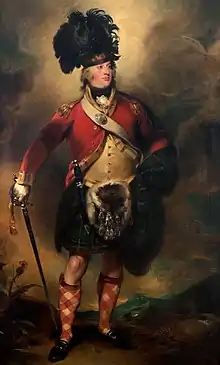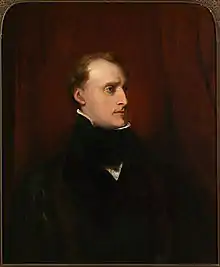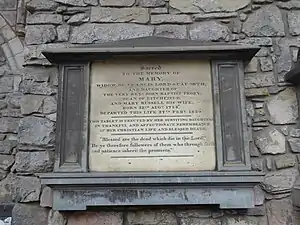Francis Mackenzie, 1st Baron Seaforth | |
|---|---|
 Lord Seaforth by Sir Thomas Lawrence | |
| Born | 9 June 1754 |
| Died | 11 January 1815 |
| Allegiance | |
| Service/ | |
| Rank | Lieutenant-General |
| Battles/wars | French Revolutionary Wars |

Lieutenant-General Francis Humberston Mackenzie, 1st Baron Seaforth, FRS, FRSE, FLS (9 June 1754 – 11 January 1815) was a British politician, soldier, and botanist. He was Chief of the Highland Clan Mackenzie, as which he raised the renowned 78th (Highlanders) Regiment of Foot.
Early life
Mackenzie was the second son of Major William Mackenzie (d. 12 March 1770), who was the son of the Hon. Alexander Mackenzie, and the grandson of Kenneth Mackenzie, 4th Earl of Seaforth.[1] Francis's mother was Mary, the daughter and heiress of Matthew Humberston of Humberston, Lincolnshire.
On the death of his elder brother Colonel Thomas Frederick Mackenzie Humberston in 1783, Francis Mackenzie became the last male heir of the attainted Earls of Seaforth.[1] When he was about twelve years of age, Francis contracted scarlet fever, which incurred the loss of his ability to hear and almost all of his ability to speak. As a consequence, he was known as MacCoinnich Bodhar (Deaf Mackenzie in Gaelic).[2]
Political and military career
From 1784 to 1790, and again from 1794 to 1796, Seaforth was Member of Parliament for the County of Ross.
In 1787, he prposed raising a regiment on his own estates, with himself as commander. The government declined his patriotic offer but accepted his services in procuring recruits for the 74th and 75th. On 19 May, 1790, he renewed his offer, yet the government declined his services again. When war broke out in 1793, he offered for a third time, and a letter of service was granted in his favour dated 7 March, 1793, empowering him as Lieutenant-Colonel-Commandant to raise a Highland Battalion to be called 78th (Highlanders) Regiment of Foot.[2]
He was appointed Lord Lieutenant of Ross-shire and was raised to the peerage of Great Britain as Lord Seaforth, Baron Mackenzie of Kintail in the County of Ross on 26 October, 1797.[3] In 1798, he was appointed Colonel of the Ross-shire Regiment of Militia.
Seaforth served as Governor of Barbados from 1800 to 1806. During his tenure, reformed slavery on the island, implemented a prohibition on killing slaves, and reduced official discrimination against free blacks.[2] As Governor of Barbados, Seaforth appointed Thomas Moody, a mathematical expert from a prominent British family,[4][5] to a direct commission in the Royal Engineers,[6] which Moody entered as a lieutenant in 1806.[4] Seaforth attained the rank of Lieutenant-General in 1808.[2]
Avocational life
In 1794, Seaforth was elected a Fellow of the Royal Society for his contributions to botany, with the genus Seaforthia named in recognition of his work. A year later, In 1795, he was elected a Fellow of the Royal Society of Edinburgh, again in acknowledgement of his contributions to botany: his proposers were Daniel Rutherford, Alexander Monro (secundus), and John Playfair. He was also a Fellow of the Linnean Society, and served as Extraordinary Director of the Highland Society.[7]
_-_Google_Art_Project.jpg.webp)
In 1796, Mackenzie gave £1,000 to Sir Thomas Lawrence to assist with Lawrence's financial difficulties. Lawrence later painted a full-length portrait of Seaforth's daughter, Mary.
Lord Seaforth commissioned Benjamin West's painting "King Alexander III of Scotland being rescued from the fury of a stag by the intrepidity of Colin Fitzgerald".[8]
Walter Scott said of him:
The last Baron of Kintail, Francis, Lord Seaforth was a nobleman of extraordinary talents, who must have made for himself a lasting reputation had not his political exertions been checked by painful natural infirmities.[9]
Seaforth nearly recovered entirely the use of his tongue, but during the last two years of his life, which he spent mourning the deaths of his four sons, he rarely spoke.[2]
Family

In 1782, Mackenzie entered matrimony with Mary Proby, the daughter of The Very Rev Baptist Proby, who served as the 7th Dean of Lichfield and Mary Russel. Mary was the niece of John Proby, 1st Baron Carysfort and sister of Rev. Charles Proby.
Francis's four legitimate sons all predeceased him as predicted by the Brahan Seer. His children were:
- William Frederick Mackenzie (died young)
- George Leveson Boucherat Mackenzie (died young)
- Hon. William Frederick Mackenzie (died 1814), MP for Ross-shire
- Hon. Francis John Mackenzie, midshipman, RN (died unmarried 1813)
- Hon. Mary Elizabeth Frederica Mackenzie, heiress to her father, (married first Admiral Sir Samuel Hood, married second Rt Hon James Alexander Stewart of Glasserton).
- Frances Catherine Mackenzie, dsp
- Caroline Elizabeth Mackenzie (accidentally killed unmarried)
- Charlotte Elizabeth Mackenzie (died unmarried)
- Augusta Anne Mackenzie (died unmarried in 1856) buried in Dean Cemetery
- Helen Anne Mackenzie (married Joshua Henry Mackenzie, Lord Mackenzie) (buried in Greyfriars Kirkyard)
References
- 1 2 Sir James Balfour Paul, The Scots Peerage, volume VII (Edinburgh, David Douglas, 1910), at pages 513–514
- 1 2 3 4 5 . Dictionary of National Biography. 1885–1900.
- ↑ "No. 14052". The London Gazette. 7 October 1797. p. 968.
- 1 2 Rupprecht, Anita (September 2012). "'When he gets among his countrymen, they tell him that he is free': Slave Trade Abolition, Indentured Africans and a Royal Commission". Slavery & Abolition. 33 (3): 435–455. doi:10.1080/0144039X.2012.668300. S2CID 144301729.
- ↑ "Codrington College, Barbados: Important Dates". 21 February 2021.
- ↑ Schomburgk, Sir Robert H. (1848). The History of Barbados. Longman, Brown, Green, and Longmans.
- ↑ Biographical Index of Former Fellows of the Royal Society of Edinburgh 1783–2002 (PDF). The Royal Society of Edinburgh. July 2006. ISBN 0-902-198-84-X. Archived from the original (PDF) on 4 March 2016. Retrieved 10 July 2017.
- ↑ "King Alexander III of Scotland being rescued from the fury of a stag by the intrepidity of Colin Fitzgerald" National Gallery
- ↑ "The Fulfillment of the Seaforth Prophecy". p. 89. Retrieved 26 February 2017.
Sources
- Mackenzie, Alexander (1894). History of the Mackenzies. Inverness: A & W Mackenzie.
- Sidney Lee (ed), Dictionary of National Biography (1891), London, Smith, Elder & Co
External links
- "Mackenzie family tree". Archived from the original on 25 December 2002.
{{cite web}}: CS1 maint: unfit URL (link) - Seaforth's Lewis by Finlay MacLeod
.svg.png.webp)